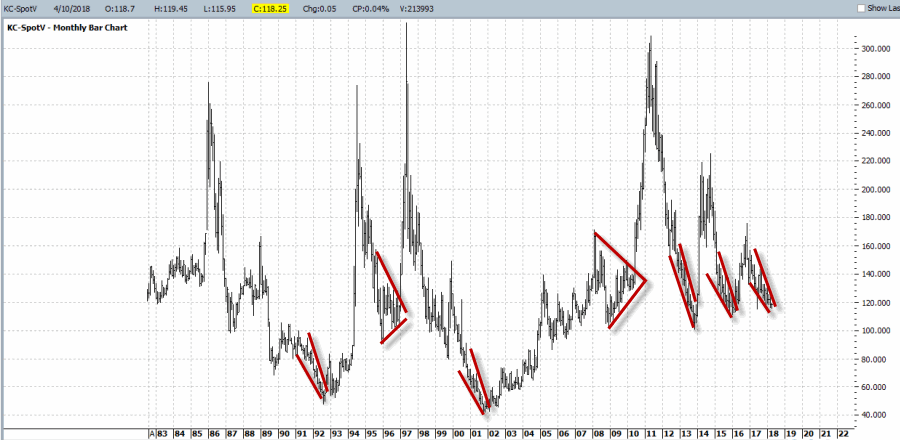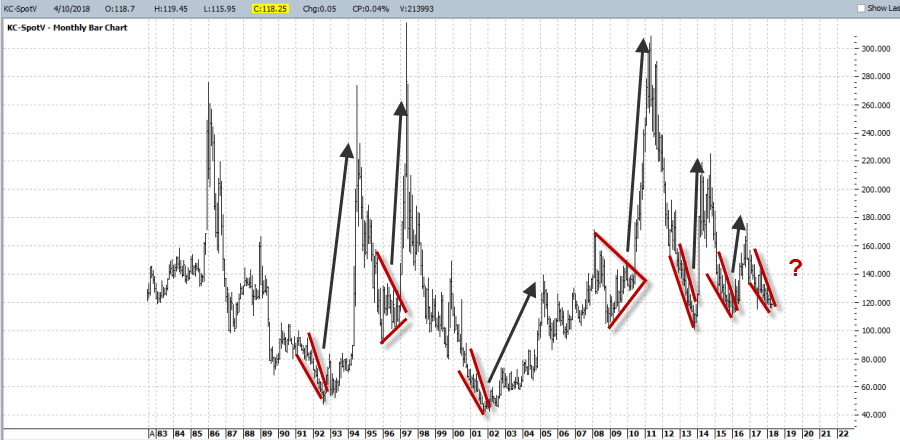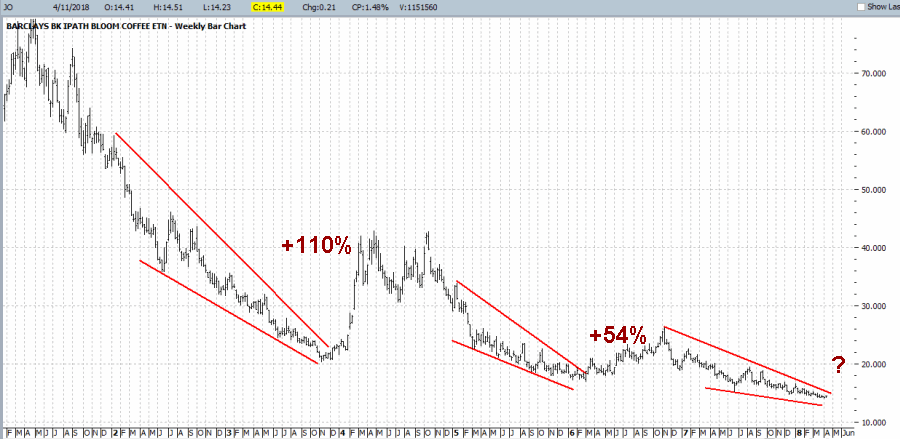After rereading much of what I have written of late, it occurs to me that maybe I should just write about those markets that are not at a critical juncture, you know, just to save time.
Speaking of which, a long time ago I read an obscure article somewhere that made a compelling argument that the 3 most important commodities in the world are the “Three C’s” – crude oil (runs everything), corn (feeds everyone) and copper (builds everything). It made sense. It still does. (Although for the record, times being what they are, I am still concerned that someday the three most important commodities may be canned food, shotgun shells and cabins in the woods, but I digress).
Yes, it makes sense all day, into the evening, overnight and into the early morning. And then you wake up and realize that the author missed the most important “C” of all – Coffee!!
Coffee, the Commodity
Like any physical commodity there are two things you need to know about coffee:
*The price fluctuates based on supply and demand
*After boom comes a bust and vice versa
To put it mildly, coffee has a “history”. To be more specific, coffee has a history of extremes booms and busts (which is what can make it an outstanding trading vehicle). Consider Figure 1 which displays a monthly bar chart for spot Coffee prices.
 Figure 1 – Monthly Spot Coffee; a History of Big Moves (Courtesy ProfitSource by HUBB)
Figure 1 – Monthly Spot Coffee; a History of Big Moves (Courtesy ProfitSource by HUBB)
The good news is that you do not have to be an expert on Brazilian weather patterns to recognize “the way it works” in coffee. The way it works, generally speaking, is this:
a) Price either collapses into a narrowing, declining range or consolidates into an every narrower sideways’ range
b) All hell breaks loose (See Figure 2)
 Figure 2 – Monthly Spot Coffee; a History of Big Moves (Courtesy ProfitSource by HUBB)
Figure 2 – Monthly Spot Coffee; a History of Big Moves (Courtesy ProfitSource by HUBB)
Part a) can be very frustrating for anyone trying to “pick tops and bottoms with uncanny accuracy” and can seem like it will never end as price grinds lower in a trend that seems like it will last forever.
Part b) can be extremely profitable. And the beauty part is in most cases you do NOT have to get in near the bottom (or top) to ride a pretty darn good trend.
The bad news until more recently is that the only way to trade coffee was to trade coffee futures. Talk about a wild ride. As someone who has traded coffee futures in the past, both professionally and personally, let me sum up the experience this way – picture downing three triple espresso’s. Then a Monster chaser. Then boarding a roller coaster. Hands Up!
Bottom line, despite the obvious potential for profit, it is clearly not for everyone.
Ticker JO, the ETF
With the advent of ETFs the marketing people “got busy” and created ETFs to fill every nook and cranny of the investment sphere. Commodities were included in this onslaught, including ticker JO (get it?) which tracks an index of coffee futures contracts. Figure 3 displays a bar chart for ticker JO. Figure 3 – Ticker JO (Courtesy ProfitSource by HUBB)
Figure 3 – Ticker JO (Courtesy ProfitSource by HUBB)
Notice anything?
Good News: If history is a guide, coffee is setting up for the next big up move.
Bad News: I can’t tell you when the trend will change.
Good News: We know for sure is that it won’t start at least until the current down trending range is broken to the upside.
Bad News: Just because price breaks above the upper red line I have arbitrarily drawn in Figure 3 doesn’t guarantee that a profitable up move will occur.
Good News: But it could. And as you have seen, when coffee “goes”, it really goes.
Other Good News: Investors can buy coffee just like buying shares of stock via JO.
So grab another cup of – what else – and keep a close eye.
Jay Kaeppel
Disclaimer: The data presented herein were obtained from various third-party sources. While I believe the data to be reliable, no representation is made as to, and no responsibility, warranty or liability is accepted for the accuracy or completeness of such information. The information, opinions and ideas expressed herein are for informational and educational purposes only and do not constitute and should not be construed as investment advice, an advertisement or offering of investment advisory services, or an offer to sell or a solicitation to buy any security.

